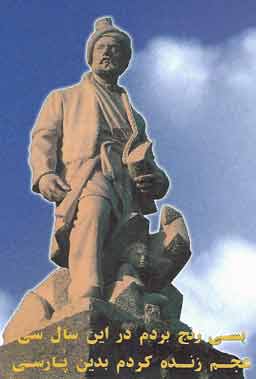|
Series:
Book Review
Author:
Dr. Mehrborzin Soroushian
Subtopics:
General
Information:
Mazda Publishers
Costa
Mesa, California
Related
Articles:
www.shahnameh.com
Related
Links:
www.mazdapub.com

Professor Shapur
Shahbazi
|
 Amongst the national heroes and the literately greats of
all times, Ferdowsi has a very special place. His one man crusade to preserve the national
identity, language and heritage of his homeland put him in great personal harms way at the
same time that it won him fame for one of the great literally masterpieces of all time. Amongst the national heroes and the literately greats of
all times, Ferdowsi has a very special place. His one man crusade to preserve the national
identity, language and heritage of his homeland put him in great personal harms way at the
same time that it won him fame for one of the great literally masterpieces of all time.
In writing his 1991 book, Dr. Shapur Shahbazi does a fine
job of researching, documenting and presenting the historical evidence about the life of
this great poem and patriot. He goes through painstaking trouble of separating historical
evidence from myths surrounding the life of this nationalistic figure. He examines his
sources and accuracy of his evidence before using it to make determination of the events
that unfolded over a millennium ago in Iran.
Dr. Shahbazi with great skill takes us over various stages
of Ferdowsi’s life, and gives us a good view of the conditions prevailing in the
homeland of Ferdowsi at the time of his living some three centuries after the fall of
Sassanian Iran to Arab invasion. He gives us a good understanding of the factors
motivating Ferdowsi to undertake the arduous task of perpetuating his sense of nationalism
in his master piece the Shah-Nameh, a feat that brought him fame on the one hand, and left
him heartbroken over the loss of his son and in financial ruins by the end of his death.
Topics such as Ferdowsi’s patrons, and his relation
with the temporal ruler Sultan Mahmud Ghazanvi are given adequate coverage as is the issue of
Ferdowsi’s religion inclinations based on the evidence he finds in the
Shah-Nameh.
Ferdowsi’s longing for ancient Iran, and his perspectives on the state of his
motherland are assessed adequately.
Dr. Shahbazi’s presentation of translation of some poetry from the Shah-Nameh into
English goes along way towards giving the reader a better appreciation of the person that
Ferdowsi was and the moral and ethical standards that he aspired to. The lifestyle and the
cultural setting that Ferdowsi engaged in manifesting his longing for the cultural norms
of the Sassanian era is brought to the reader in a vivid way.
In short, Dr. Shahbazi does a great job of introducing his
reader to the world of Ferdowsi through his book that can serve as a great reference
source.
|